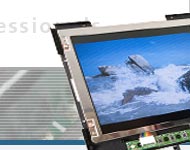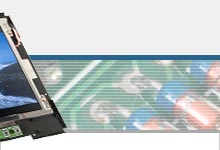 |
 |
 |
 |
Technology LCD Displays / Passive Displays
|
 |
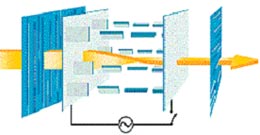  |
 |
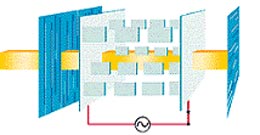  |
| LCD cell in inactivated
state |
 |
LCD cell in activated
state |
Liquid crystals have the property of changing their alignment
when an electrical voltage, resp. electrical field, is applied.
In this way, it is possible to allow light to pass, or not to
pass, through the cell.
 
Contrast
The contrast value is always the ratio of the brightness of
the activated, resp. inactivated pixels.
Brightness of pixels in
inactivated state
K = --------------------------------------------------------
Brightness of pixels in
activated state
The contrast is therefore always given as a ratio without a
unit, e.g. 20:1
 
Viewing Angle
The viewing angle is used to refer to the angle at which the
display reaches a particular contrast ratio. The reference contrast
value is specified according to the viewing angle.
Usually four angles are given: the angles measured from the
centre to left and right, as well as the angle measured from
the centre to the top and the bottom.
|
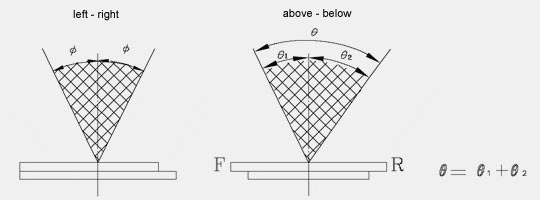 |
 
Viewing Direction
The viewing direction refers to the preferred viewing angle
of an LCD display.
Particularly in the case of passive displays, the viewing angles
are not identical from all sides.
Due to the production process, there is always a larger viewing
angle on one side (always viewed from the middle of the display).
A clock-face is used to indicate this preferred side.
For example, if the viewing angle of a display is largest from
the middle to the bottom, the viewing direction will be indicated
as 6 o’clock.
By adjusting the production process, the viewing direction can
be turned in practically any direction. In this way, a display
can be adapted to the clients’ requirements.
If a display is installed in such a way that the viewer sees
it from below, then it is possible to build in a viewing direction
of 6 o’clock.
Should the display be viewed from above, a 12 o'clock display
can be fitted.
It is also possible to produce displays with a viewing direction
of 3 o'clock or 9 o'clock.
|
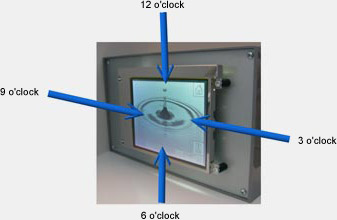 |
 
Positive und Negative Mode
A passive LCD can either be produced in positive mode or negative
mode.
Positive mode means that the activated pixels are dark and the
background is light.
Negative mode means that the activated pixels are light and
the background is dark.
With the use of software, the display can be inverted.
|
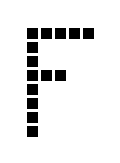  |
 |
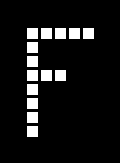  |
 |
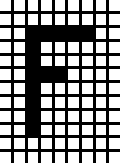  |
 |
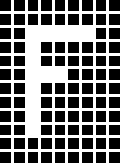  |
| Positive Mode |
 |
Negative Mode |
 |
Negative Mode Inverted
by software |
 |
Positive Mode
Inverted by software |
 
Reflective / Transmissive / Transflective
The function of an LCD is based on the fact that light flows
from the back to the front of the LCD cell. In this way, light
can either come from behind (background lighting) or from the
front (surrounding light, e.g. the sun). If the light comes
from the front, it must be reflected on the back of the display.
According to the application and requirements, the display can
be assembled in three ways:
Reflective
There is a reflector behind the actual LCD cell which completely
reflects the light entering from the front. A reflective display
only works with surrounding light: the readability improving
the lighter the surrounding is (sun light).
Advantages:
Disadvantages: |
– low power
consumption (needs no background lighting)
– cannot be read in dark surroundings |
|
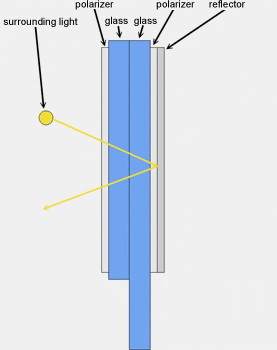 |
Transmissive
A transmissive display only works with the light of the background
lighting. The readability improves the darker the surrounding
is.
Advantages:
Disadvantages: |
– very good readability in dark
surroundings
– readability deteriorates with strong surrounding
light (direct sun light).
– the background lighting must always be switched
on (power consumption, life span). |
|
 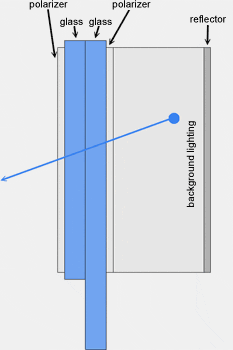 |
Transflective
A semi-transmitting, reflective film is mounted behind the LCD
cell. This means that the surrounding light entering from the
front can be reflected, as well as allowing the light of the
background lighting to flow to the front.
Advantages:
Disadvantages: |
– good readability in all environments
(light or dark)
– the background lighting can be switched off in
light surroundings (power saving).
– A transflective display is a compromise between
a reflective and a transmissive display.
In extreme conditions (very light or very dark surroundings),
a transflective display does not achieve the same good
results as a reflective or transmissive
display. |
|
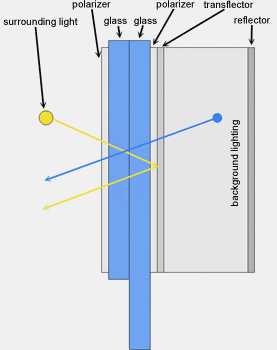 |
 
Background lighting
Different background lighting can be used, depending on the
size and usage:
CCFL (Cold Cathode Fluorescent Lamp)
A CCFL tube generates a bright, white light.
To operate, an inverter is necessary, which generates an alternating-high
voltage of 400-600 V. The clock rate of the alternating voltage
typically lies between 30 to 50 kHz and usually causes considerable
EMC disturbances.
Due to the high brightness, CCFL tubes are used for larger displays.
With very large displays, several tubes can be used.
LED (Light Emitting Diode)
LEDs are used, either as a matrix to the direct lighting of an
LCD, or as LED-strips with a light conductor as background lighting.
LEDs are available in different colours (yellow-green, white,
blue, orange, red, etc) and allow a high variability (e.g. mixing
of colours, etc).
The brightness of LEDs is smaller than that of CCFL tubes, which
is why, for construction and economic considerations, LED background
lighting is only used for display sizes up to approximately
5.7’’.
EL foil
An EL foil consists of a phosphor layer which emits light when
an alternating voltage is applied. The foil is very thin, which
brings construction advantages in the design of an LCD module.
The necessary alternating voltage is generated by an inverter,
which in turn can cause EMC problems.
Different colours are available (blue, turquoise, green, yellow,
red, white, etc).
Luminova film
Luminova consists of a fluorescent layer, which still glows
for up to two hours in the darkness. Luminova film does not
require any power supply.
Life span of background lighting
The life span of an LCD is defined by the life span of the background
lighting.
The brightness of the background lighting decreases with the
operating time. The end of the life span is defined when only
50% of the original brightness remains.
Typical values for background lightings:
CCFL: 10'000 to 50'000 h
LED: white & blue: 10'000 to 20'000 h
yellow-green: 100'000 h
EL-Folie: 3'000 to 10'000 h
 
Application of LCD displays
General information
An LCD consists of a combination of glass and a polarizer. The
polarizers are made from a stretched synthetic film. The following
safety regulations should be kept:
- The temperature values which are indicated in the specifications
should be maintained during operation and storage. Polarizer
degeneration, the build-up of blisters, or the peeling-off
of the polarizer itself can occur with humidity, or if the
temperatures are too high.
So-called vacuoles can develop if temperatures are too low,
an irreversible damage, which affects the liquid crystals.
Particular care should be taken that no condensation builds
up on the LCD. If the storage is in a warm environment at
above 40°C, the relative humidity should lie under 60%.
While in operation, constructive measures (fans, mechanical
measures) should ensure that no condensation occurs.
- The polarizer may not be touched, pressed or rubbed with
hard objects (e.g. glass, ball-point pens, etc.).
- The LCD may not be cleaned with products containing acetone,
toluene, ethanol, or isopropyl alcohol. Hexane is recommended
for cleaning purposes.
The display can be cleaned with a soft, antistatic cloth
(e.g. cloth used to clean glasses) and possibly some petroleum
ether, if the display has dust on the surface.
Oil, fat, saliva and water should be removed from the display
as quickly as possible.
- Glass is breakable! Avoid any impacts, particularly on
the edges and corners of the display.
ESD measures
LCD modules are usually equipped with CMOS-ICs. Therefore, the
same care should be taken in handling LCD modules as with pure
CMOS components:
- When handling LCD modules, the operator must be earthed.
- Before the LCD module is taken out of the electrostatic
packaging, it is necessary to ensure that the operator and
the LCD module have the same electrical potential.
- If soldering is necessary on the LCD module, it must be
ensured that the soldering equipment is earthed.
- If the LCD needs to be screwed onto something, the screwdriver
must be earthed (especially with electrical screwdrivers).
- Working clothes and the workplace must be earthed.
- To avoid the generation of electrostatic fields, the air
in the workroom should not be too dry (a relative humidity
of 50 to 60% is recommended).
Soldering on LCD modules
If a plug, cable, or something similar needs to be soldered
onto an LCD module, the following parameters must be kept:
Soldering temperature: max. 260°C
Soldering time: max. 3 to 4 seconds
Unless a halogen-free soldering flux is used, the flux should
be removed from the LCD module after the soldering process.
The surface of the display should be safeguarded by a protective
foil or cover against soldering splashes.
Safety
Should the glass of an LCD display break, there are likely to
be sharp edges. Depending on the use, certain measures have
to be taken so that the user will not suffer injury in the incident
of glass breakage (e.g. cars).
Should the liquid crystals leak out of the display, any body
parts which have come into contact with this should be washed
with soap and water.
Liquid crystals should never be swallowed. Even though toxicity
is extremely low, the utmost care should be taken when handling
liquid crystals.
 
Passive LCD / Passive Displays
Passive displays contain no active electronic components between
the two glass plates (as opposed to TFT).
All the necessary components to control the LCDs are to be found
as an IC on the outside of the active surface.
TN (Twisted Nematic)
This is the simplest LCD technology. The angle of rotation of
the liquid crystal is 90°.
This technology is used for smaller displays up to a multiplex
rate of around 1/32 Duty:
these are mainly used for segment displays and in the automotive
industry.
HTN (High Twisted Nematic)
The angle of rotation of the liquid crystal is 120°. This
leads to a better viewing angle and better contrast as opposed
to TN technology. HTN has the same limitations as TN.
STN (Super Twisted Nematic)
Here, the liquid crystal has an angle of rotation of 170°
to 270°.
For displays with a larger Duty (from 1/16) better viewing angles
and contrasts can be produced.
STN displays can be manufactured with the background colours
of yellow-green, grey, or blue.
FSTN (Film STN)
An additional synthetic film (retardation film) placed on
the surface of the display ensures that the display can be seen
with either a white background and black pixels (or the other
way around). See positive and negative mode.
DSTN (Double STN)
To compensate the temperature dependence of the LCD cell,
a second LCD cell is mounted on the first. The direction of
rotation of the liquid crystal in both cells is counter rotating.
Consequently, the effects of temperature dependence are cancelled.
This technology is time-consuming and therefore expensive to
produce and is mainly applied in the car industry.
CSTN (Color STN)
An additional colour filter in the colours of red, green and blue is placed between
the glass plates. A pixel of a CSTN module consists of three
sub-pixels with the colours of red, green and blue.
Through differential controlling of the brightness of the three
sub-pixels, the human eye perceives all three sub-pixels as
a single pixel of the mixed colours.
|
|
 |
|
 |

|
 |

Admatec AG
Fabrikstrasse 10
CH-4614 Hägendorf
Fon +41 62 896 00 48
Fax +41 62 896 25 80
info
  
|
|
 |
